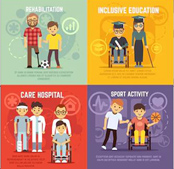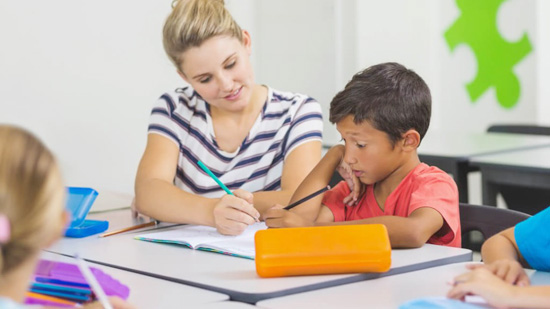In today’s educational landscape, inclusivity plays a crucial role in ensuring that every student, regardless of their abilities or disabilities, receives an education that maximizes their potential. Determining the least restrictive environment for students with disabilities is a complex process that requires careful consideration of various factors.
This article explores key principles and strategies that can help educators and parents make informed decisions about the educational setting that will best support the individual needs of students with disabilities. From mainstream classrooms to specialized programs, there are a range of options available to promote the inclusion and academic success of these students.

Photo by spedtrack
By understanding the least restrictive environment concept and its legal implications, as well as considering factors like individualized education programs (IEPs) and the importance of socialization, we can create environments that foster learning and personal growth for students with disabilities. Join us as we delve into this topic and provide practical guidance on determining the least restrictive environment to support these students on their educational journey.
Understanding the Least Restrictive Environment (LRE) in Special Education
The concept of the least restrictive environment (LRE) is a fundamental principle in special education that emphasizes the importance of providing students with disabilities the opportunity to be educated alongside their non-disabled peers to the maximum extent appropriate. The LRE is the educational setting in which a student with disabilities can receive an appropriate education that meets their unique needs while also being included in the general education environment to the greatest extent possible.
Determining the LRE requires careful consideration of various factors, including the student’s individual needs, abilities, and the available educational options. It is essential to strike a balance between providing the necessary support and accommodations for students with disabilities while also promoting their active participation and social integration within the general education setting.
Importance of Determining the LRE for Students with Disabilities
Determining the least restrictive environment is crucial for ensuring that students with disabilities receive an education that is tailored to their individual needs and maximizes their potential for academic and social growth. Placing students in an environment that is too restrictive can hinder their development and limit their opportunities for learning and interaction with their non-disabled peers.
On the other hand, placing students in an environment that is too general can also pose challenges, as they may not receive the specialized support and accommodations necessary to address their unique needs. Striking the right balance is essential to create an inclusive and supportive educational environment that promotes the academic and social success of students with disabilities.
Legal Requirements for Determining the LRE
Determining the least restrictive environment for students with disabilities is not only a pedagogical consideration but also a legal requirement. The Individuals with Disabilities Education Act (IDEA), a federal law that governs special education in the United States, mandates that students with disabilities should be educated in the least restrictive environment to the maximum extent appropriate.
IDEA requires schools to provide a continuum of placement options, ranging from regular education classrooms with supplementary aids and services to special education classrooms, separate schools, or residential facilities, based on the individual needs of each student. The law also emphasizes the importance of ensuring that students with disabilities are not removed from the general education environment solely due to their disabilities.
Factors to Consider When Determining the LRE
When determining the least restrictive environment for students with disabilities, several factors need to be taken into account. Each student is unique, and their specific needs and abilities should guide the decision-making process. Here are some key factors to consider:
Academic Abilities
Assessing a student’s academic abilities is crucial in determining the appropriate educational setting. Consider their current academic performance, any specialized instructional strategies they may require, and whether they can effectively access the general education curriculum with or without modifications.
Socialization and Peer Interaction
Socialization is a vital aspect of the educational experience. Consider the student’s social skills, ability to interact with peers, and the potential benefits of being included in a general education setting for their social and emotional development.
Related Services and Supports
Determine the type and extent of related services and supports the student requires to access the curriculum and make progress. This may include speech therapy, occupational therapy, assistive technology, or specialized instruction.
Individualized Education Program (IEP)
The student’s IEP plays a central role in determining the least restrictive environment. The IEP team, which includes parents, teachers, and other professionals, should collaboratively develop the IEP goals and placement decisions based on the student’s unique needs and abilities.
Continuum of Placement Options in Special Education
In special education, a continuum of placement options refers to the range of educational settings available to students with disabilities. It encompasses a spectrum of placements, from the general education classroom with supplementary aids and services to more specialized settings. Each placement option offers varying levels of support and accommodations based on the student’s individual needs.
The continuum of placement options includes:
General Education Classroom
Inclusion in the general education classroom is considered the least restrictive environment for students with disabilities. It provides opportunities for socialization, exposure to grade-level curriculum, and interaction with non-disabled peers. Supplementary aids and services, such as assistive technology or individualized instruction, may be provided to support the student’s participation and progress.
Resource Room
A resource room is a separate setting where students with disabilities receive specialized instruction and support in small groups. It allows for targeted interventions and individualized instruction while still providing opportunities for integration with their peers in the general education setting.
Specialized Programs
Some students may require more intensive support and instruction in specialized programs, such as special day classes or specialized schools. These programs offer a highly structured and individualized learning environment tailored to meet the unique needs of students with disabilities.
Homebound or Hospital Instruction
In cases where a student’s medical condition or disability prevents them from attending school, homebound or hospital instruction may be provided. Qualified instructors deliver instruction to the student in their home or hospital setting.
Evaluating the Student’s Needs and Abilities
To determine the least restrictive environment for a student with disabilities, it is essential to conduct a comprehensive evaluation of their needs and abilities. This evaluation should consider various aspects, including:
Cognitive Abilities: Assess the student’s cognitive abilities to determine their learning style, processing speed, and ability to comprehend and apply information.
Communication Skills: Evaluate the student’s communication skills, including their expressive and receptive language abilities. Consider whether they require augmentative and alternative communication (AAC) devices or specialized communication strategies.
Physical and Sensory Needs: Identify any physical or sensory needs the student may have, such as mobility impairments, visual or hearing impairments, or sensory processing difficulties. Determine the accommodations and supports required to address these needs effectively.
Behavioral Considerations: If the student presents challenging behaviors, evaluate the underlying causes and develop strategies to address them effectively. Consider whether a specialized behavior intervention plan is necessary and how it can be implemented in different educational settings.
Collaborating with Parents and Other Professionals
Collaboration between parents, educators, and other professionals is essential in determining the least restrictive environment for students with disabilities. The input and expertise of each stakeholder contribute to a comprehensive understanding of the student’s strengths, challenges, and needs. By working together, the team can develop a holistic plan that supports the student’s educational journey.
Parents play a crucial role in advocating for their child’s needs and providing valuable insights into their abilities and preferences. Their perspectives and concerns should be taken into consideration when making placement decisions. Additionally, involving other professionals, such as special education teachers, therapists, or related service providers, can provide valuable expertise and ensure a multidisciplinary approach to determining the LRE.
Individualized Education Program (IEP) and the LRE
The Individualized Education Program (IEP) is a legally binding document that outlines the educational goals, services, and accommodations for students with disabilities. It plays a central role in determining the least restrictive environment.
The IEP team, which includes parents, teachers, and other professionals, should explicitly address the LRE considerations within the IEP. The team should discuss placement options and justify their decision based on the student’s unique needs and abilities. The IEP should also outline the supplementary aids and services, modifications, and accommodations necessary to support the student’s participation and progress in the chosen placement.
Strategies for Promoting Inclusion in the LRE
Promoting inclusion in the least restrictive environment requires intentional strategies and practices. Here are some approaches that can foster an inclusive educational environment for students with disabilities:
Universal Design for Learning (UDL)
Implement UDL principles to create a flexible and accessible curriculum that meets the diverse learning needs of all students. Provide multiple means of representation, expression, and engagement to ensure that students can access and demonstrate their learning in various ways.
Collaborative Teaching
Encourage collaboration between general education and special education teachers to provide differentiated instruction and support within the general education classroom. This collaborative approach allows for shared expertise and maximizes the benefits of inclusion for all students.
Peer Support Programs
Implement peer support programs, such as peer tutoring or buddy systems, to facilitate positive social interactions and relationships between students with and without disabilities. These programs can promote understanding, empathy, and inclusion among peers.
Professional Development
Provide ongoing professional development opportunities for educators to enhance their knowledge and skills in supporting students with disabilities in the general education setting. Training on inclusive practices, differentiated instruction, and behavior management strategies can help create a supportive and inclusive learning environment.
Ensuring a Supportive and Inclusive Educational Environment for All Students with Disabilities
Determining the least restrictive environment for students with disabilities is a complex process that requires careful consideration of various factors. By understanding the least restrictive environment concept, legal requirements, and factors to consider, educators and parents can make informed decisions that promote the inclusion and academic success of these students.
Collaboration, individualized planning, and intentional strategies can create supportive and inclusive educational environments that foster learning and personal growth for students with disabilities. Together, we can ensure that every student has the opportunity to thrive and reach their full potential, regardless of their abilities or disabilities.




